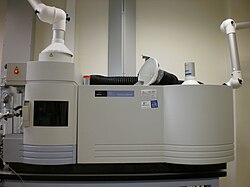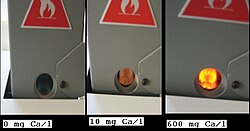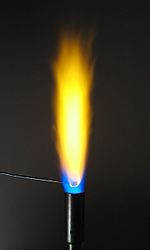139:
must be in a liquid solution. Inductively coupled plasma (ICP) source of the emission consists of an induction coil and plasma. An induction coil is a coil of wire that has an alternating current flowing through it. This current induces a magnetic field inside the coil, coupling a great deal of energy to plasma contained in a quartz tube inside the coil. Plasma is a collection of charged particles (cations and electrons) capable, by virtue of their charge, of interacting with a magnetic field. The plasmas used in atomic emissions are formed by ionizing a flowing stream of argon gas. Plasma's high-temperature results from resistive heating as the charged particles move through the gas. Because plasmas operate at much higher temperatures than flames, they provide better atomization and a higher population of excited states. The predominant form of sample matrix in ICP-AES today is a liquid sample: acidified water or solids digested into aqueous forms. Liquid samples are pumped into the nebulizer and sample chamber via a peristaltic pump. Then the samples pass through a nebulizer that creates a fine mist of liquid particles. Larger water droplets condense on the sides of the spray chamber and are removed via the drain, while finer water droplets move with the argon flow and enter the plasma. With plasma emission, it is possible to analyze solid samples directly. These procedures include incorporating electrothermal vaporization, laser and spark ablation, and glow-discharge vaporization.
116:
79:
1258:
688:
20:
712:
91:
724:
1270:
700:
374:
162:. In traditional arc spectroscopy methods, a sample of the solid was commonly ground up and destroyed during analysis. An electric arc or spark is passed through the sample, heating it to a high temperature to excite the atoms within it. The excited analyte atoms emit light at characteristic wavelengths that can be dispersed with a
138:
Advantages of ICP-AES are the excellent limit of detection and linear dynamic range, multi-element capability, low chemical interference and a stable and reproducible signal. Disadvantages are spectral interferences (many emission lines), cost and operating expense and the fact that samples typically
86:
The sample of a material (analyte) is brought into the flame as a gas, sprayed solution, or directly inserted into the flame by use of a small loop of wire, usually platinum. The heat from the flame evaporates the solvent and breaks intramolecular bonds to create free atoms. The thermal energy also
87:
excites the atoms into excited electronic states that subsequently emit light when they return to the ground electronic state. Each element emits light at a characteristic wavelength, which is dispersed by a grating or prism and detected in the spectrometer.
240:
Stefánsson A, Gunnarsson I, Giroud N (2007). "New methods for the direct determination of dissolved inorganic, organic and total carbon in natural waters by
Reagent-Free Ion Chromatography and inductively coupled plasma atomic emission spectrometry".
170:. However, modern spark sources with controlled discharges can be considered quantitative. Both qualitative and quantitative spark analysis are widely used for production quality control in foundry and metal casting facilities.
1089:
189:
110:
635:
762:
154:
atomic emission spectroscopy is used for the analysis of metallic elements in solid samples. For non-conductive materials, the sample is ground with
406:
378:
980:
166:
and detected. In the past, the spark or arc conditions were typically not well controlled, the analysis for the elements in the sample were
913:
858:
827:
822:
295:
1195:
1013:
875:
1144:
963:
101:
A frequent application of the emission measurement with the flame is the regulation of alkali metals for pharmaceutical analytics.
97:
atomic ions emitting light in a flame displays a brilliantly bright yellow emission at 588.9950 and 589.5924 nanometers wavelength.
1084:
886:
807:
787:
361:
276:
Mermet, J. M. (2005). "Is it still possible, necessary and beneficial to perform research in ICP-atomic emission spectrometry?".
1030:
1008:
755:
658:
446:
1096:
1018:
704:
953:
898:
848:
194:
543:
399:
1180:
932:
748:
343:
320:
1185:
1003:
1200:
1170:
1101:
1035:
728:
1301:
1296:
1129:
920:
817:
665:
431:
179:
1306:
1274:
927:
832:
692:
392:
66:
gives the identity of the element while the intensity of the emitted light is proportional to the number of
1061:
797:
1217:
1056:
1025:
958:
436:
1207:
1149:
998:
870:
609:
124:
1233:
1212:
853:
512:
502:
335:
128:
975:
296:
http://www.rsc.org/publishing/journals/JA/article.asp?doi=b416511j%7Cformat=%7Caccessdate=2007-08-31
583:
1106:
802:
672:
553:
461:
147:
893:
651:
1262:
1134:
865:
779:
451:
507:
471:
423:
415:
59:
8:
1190:
903:
812:
548:
184:
1238:
1175:
1154:
970:
948:
881:
792:
578:
573:
568:
441:
365:
313:
Atomic absorption, fluorescence, and flame emission spectroscopy: a practical approach
1139:
1066:
1040:
711:
644:
619:
614:
604:
517:
476:
456:
339:
316:
258:
222:
63:
35:
716:
624:
285:
250:
167:
132:
55:
43:
497:
51:
254:
1290:
563:
163:
115:
771:
599:
522:
262:
151:
78:
47:
16:
Analytical method using radiation to identify chemical elements in a sample
332:
Element-specific chromatographic detection by atomic emission spectroscopy
226:
123:
Inductively coupled plasma atomic emission spectroscopy (ICP-AES) uses an
492:
558:
466:
384:
159:
19:
527:
289:
90:
155:
82:
A flame during the assessment of calcium ions in a flame photometer
740:
373:
94:
310:
70:
of the element. The sample may be excited by various methods.
39:
67:
54:
at a particular wavelength to determine the quantity of an
239:
190:
Inductively coupled plasma atomic emission spectroscopy
111:
Inductively coupled plasma atomic emission spectroscopy
23:
Inductively coupled plasma atomic emission spectrometer
119:Inductively coupled plasma atomic emission source
1288:
38:that uses the intensity of light emitted from a
329:
131:at wavelengths characteristic of a particular
756:
400:
104:
828:Vibrational spectroscopy of linear molecules
212:
127:to produce excited atoms and ions that emit
233:
823:Nuclear resonance vibrational spectroscopy
763:
749:
407:
393:
206:
1196:Inelastic electron tunneling spectroscopy
876:Resonance-enhanced multiphoton ionization
311:Reynolds, R. J.; Thompson, K. C. (1978).
964:Extended X-ray absorption fine structure
414:
114:
89:
77:
18:
362:"Atomic Emission Spectroscopy Tutorial"
1289:
659:Analytical and Bioanalytical Chemistry
275:
744:
447:High-performance liquid chromatograph
388:
1269:
699:
195:Laser-induced breakdown spectroscopy
723:
58:in a sample. The wavelength of the
13:
14:
1318:
1181:Deep-level transient spectroscopy
933:Saturated absorption spectroscopy
354:
1268:
1257:
1256:
1186:Dual-polarization interferometry
770:
722:
710:
698:
687:
686:
372:
142:
1201:Scanning tunneling spectroscopy
1176:Circular dichroism spectroscopy
1171:Acoustic resonance spectroscopy
303:
213:Stáhlavská A (April 1973). "".
1130:Fourier-transform spectroscopy
818:Vibrational circular dichroism
432:Atomic absorption spectrometer
269:
180:Atomic absorption spectroscopy
1:
928:Cavity ring-down spectroscopy
833:Thermal infrared spectroscopy
200:
1062:Inelastic neutron scattering
379:Atomic emission spectroscopy
28:Atomic emission spectroscopy
7:
1123:Data collection, processing
999:Photoelectron/photoemission
437:Flame emission spectrometer
173:
10:
1325:
1208:Photoacoustic spectroscopy
1150:Time-resolved spectroscopy
125:inductively coupled plasma
108:
105:Inductively coupled plasma
1252:
1234:Astronomical spectroscopy
1226:
1213:Photothermal spectroscopy
1163:
1122:
1115:
1077:
1049:
991:
941:
841:
778:
682:
633:
592:
536:
513:Ion mobility spectrometry
503:Electroanalytical methods
485:
422:
336:American Chemical Society
255:10.1016/j.aca.2006.09.001
129:electromagnetic radiation
73:
1218:Pump–probe spectroscopy
1107:Ferromagnetic resonance
899:Laser-induced breakdown
673:Analytical Biochemistry
462:Melting point apparatus
330:Uden, Peter C. (1992).
914:Glow-discharge optical
894:Raman optical activity
808:Rotational–vibrational
652:Analytica Chimica Acta
120:
98:
83:
24:
1302:Scientific techniques
1297:Emission spectroscopy
1135:Hyperspectral imaging
544:Coning and quartering
452:Infrared spectrometer
278:J. Anal. At. Spectrom
118:
93:
81:
22:
1307:Analytical chemistry
887:Coherent anti-Stokes
842:UV–Vis–NIR "Optical"
666:Analytical Chemistry
508:Gravimetric analysis
472:Optical spectrometer
416:Analytical chemistry
381:at Wikimedia Commons
60:atomic spectral line
1191:Hadron spectroscopy
981:Conversion electron
942:X-ray and Gamma ray
849:Ultraviolet–visible
315:. New York: Wiley.
185:Atomic spectroscopy
1239:Force spectroscopy
1164:Measured phenomena
1155:Video spectroscopy
859:Cold vapour atomic
579:Separation process
574:Sample preparation
158:powder to make it
121:
99:
84:
25:
1284:
1283:
1248:
1247:
1140:Spectrophotometry
1067:Neutron spin echo
1041:Beta spectroscopy
954:Energy-dispersive
738:
737:
620:Standard addition
615:Internal standard
605:Calibration curve
518:Mass spectrometry
477:Spectrophotometer
457:Mass spectrometer
442:Gas chromatograph
377:Media related to
64:emission spectrum
36:chemical analysis
34:) is a method of
1314:
1272:
1271:
1260:
1259:
1120:
1119:
1031:phenomenological
780:Vibrational (IR)
765:
758:
751:
742:
741:
726:
725:
714:
702:
701:
690:
689:
625:Isotope dilution
409:
402:
395:
386:
385:
376:
369:
364:. Archived from
349:
334:. Columbus, OH:
326:
298:
293:
290:10.1039/b416511j
273:
267:
266:
243:Anal. Chim. Acta
237:
231:
230:
210:
1324:
1323:
1317:
1316:
1315:
1313:
1312:
1311:
1287:
1286:
1285:
1280:
1244:
1222:
1159:
1111:
1073:
1045:
987:
937:
837:
798:Resonance Raman
774:
769:
739:
734:
678:
629:
588:
532:
481:
424:Instrumentation
418:
413:
360:
357:
352:
346:
323:
306:
301:
274:
270:
238:
234:
211:
207:
203:
176:
145:
113:
107:
76:
17:
12:
11:
5:
1322:
1321:
1310:
1309:
1304:
1299:
1282:
1281:
1279:
1278:
1266:
1253:
1250:
1249:
1246:
1245:
1243:
1242:
1236:
1230:
1228:
1224:
1223:
1221:
1220:
1215:
1210:
1205:
1204:
1203:
1193:
1188:
1183:
1178:
1173:
1167:
1165:
1161:
1160:
1158:
1157:
1152:
1147:
1142:
1137:
1132:
1126:
1124:
1117:
1113:
1112:
1110:
1109:
1104:
1099:
1094:
1093:
1092:
1081:
1079:
1075:
1074:
1072:
1071:
1070:
1069:
1059:
1053:
1051:
1047:
1046:
1044:
1043:
1038:
1033:
1028:
1023:
1022:
1021:
1016:
1014:Angle-resolved
1011:
1006:
995:
993:
989:
988:
986:
985:
984:
983:
973:
968:
967:
966:
961:
956:
945:
943:
939:
938:
936:
935:
930:
925:
924:
923:
918:
917:
916:
901:
896:
891:
890:
889:
879:
873:
868:
863:
862:
861:
851:
845:
843:
839:
838:
836:
835:
830:
825:
820:
815:
810:
805:
800:
795:
790:
784:
782:
776:
775:
768:
767:
760:
753:
745:
736:
735:
733:
732:
720:
708:
696:
683:
680:
679:
677:
676:
669:
662:
655:
648:
640:
638:
631:
630:
628:
627:
622:
617:
612:
607:
602:
596:
594:
590:
589:
587:
586:
581:
576:
571:
566:
561:
556:
551:
546:
540:
538:
534:
533:
531:
530:
525:
520:
515:
510:
505:
500:
498:Chromatography
495:
489:
487:
483:
482:
480:
479:
474:
469:
464:
459:
454:
449:
444:
439:
434:
428:
426:
420:
419:
412:
411:
404:
397:
389:
383:
382:
370:
368:on 2006-05-01.
356:
355:External links
353:
351:
350:
344:
327:
321:
307:
305:
302:
300:
299:
268:
232:
204:
202:
199:
198:
197:
192:
187:
182:
175:
172:
144:
141:
109:Main article:
106:
103:
75:
72:
15:
9:
6:
4:
3:
2:
1320:
1319:
1308:
1305:
1303:
1300:
1298:
1295:
1294:
1292:
1277:
1276:
1267:
1265:
1264:
1255:
1254:
1251:
1240:
1237:
1235:
1232:
1231:
1229:
1225:
1219:
1216:
1214:
1211:
1209:
1206:
1202:
1199:
1198:
1197:
1194:
1192:
1189:
1187:
1184:
1182:
1179:
1177:
1174:
1172:
1169:
1168:
1166:
1162:
1156:
1153:
1151:
1148:
1146:
1143:
1141:
1138:
1136:
1133:
1131:
1128:
1127:
1125:
1121:
1118:
1114:
1108:
1105:
1103:
1100:
1098:
1095:
1091:
1088:
1087:
1086:
1083:
1082:
1080:
1076:
1068:
1065:
1064:
1063:
1060:
1058:
1055:
1054:
1052:
1048:
1042:
1039:
1037:
1034:
1032:
1029:
1027:
1024:
1020:
1017:
1015:
1012:
1010:
1007:
1005:
1002:
1001:
1000:
997:
996:
994:
990:
982:
979:
978:
977:
974:
972:
969:
965:
962:
960:
957:
955:
952:
951:
950:
947:
946:
944:
940:
934:
931:
929:
926:
922:
919:
915:
912:
911:
910:
907:
906:
905:
902:
900:
897:
895:
892:
888:
885:
884:
883:
880:
877:
874:
872:
871:Near-infrared
869:
867:
864:
860:
857:
856:
855:
852:
850:
847:
846:
844:
840:
834:
831:
829:
826:
824:
821:
819:
816:
814:
811:
809:
806:
804:
801:
799:
796:
794:
791:
789:
786:
785:
783:
781:
777:
773:
766:
761:
759:
754:
752:
747:
746:
743:
731:
730:
721:
719:
718:
713:
709:
707:
706:
697:
695:
694:
685:
684:
681:
675:
674:
670:
668:
667:
663:
661:
660:
656:
654:
653:
649:
647:
646:
642:
641:
639:
637:
632:
626:
623:
621:
618:
616:
613:
611:
610:Matrix effect
608:
606:
603:
601:
598:
597:
595:
591:
585:
582:
580:
577:
575:
572:
570:
569:Pulverization
567:
565:
562:
560:
557:
555:
552:
550:
547:
545:
542:
541:
539:
535:
529:
526:
524:
521:
519:
516:
514:
511:
509:
506:
504:
501:
499:
496:
494:
491:
490:
488:
484:
478:
475:
473:
470:
468:
465:
463:
460:
458:
455:
453:
450:
448:
445:
443:
440:
438:
435:
433:
430:
429:
427:
425:
421:
417:
410:
405:
403:
398:
396:
391:
390:
387:
380:
375:
371:
367:
363:
359:
358:
347:
345:0-8412-2174-X
341:
337:
333:
328:
324:
322:0-470-26478-0
318:
314:
309:
308:
297:
291:
287:
283:
279:
272:
264:
260:
256:
252:
248:
244:
236:
228:
224:
220:
217:(in German).
216:
209:
205:
196:
193:
191:
188:
186:
183:
181:
178:
177:
171:
169:
165:
164:monochromator
161:
157:
153:
149:
143:Spark and arc
140:
136:
134:
130:
126:
117:
112:
102:
96:
92:
88:
80:
71:
69:
65:
61:
57:
53:
49:
45:
41:
37:
33:
29:
21:
1273:
1261:
1241:(a misnomer)
1227:Applications
1145:Time-stretch
1036:paramagnetic
908:
854:Fluorescence
772:Spectroscopy
727:
715:
703:
691:
671:
664:
657:
650:
643:
636:publications
600:Chemometrics
584:Sub-sampling
523:Spectroscopy
366:the original
331:
312:
304:Bibliography
281:
277:
271:
249:(1): 69–74.
246:
242:
235:
221:(4): 238–9.
218:
214:
208:
146:
137:
122:
100:
85:
31:
27:
26:
813:Vibrational
729:WikiProject
593:Calibration
554:Dissolution
493:Calorimetry
168:qualitative
1291:Categories
1019:Two-photon
921:absorption
803:Rotational
634:Prominent
559:Filtration
486:Techniques
467:Microscope
201:References
160:conductive
1097:Terahertz
1078:Radiowave
976:Mössbauer
528:Titration
284:: 11–16.
215:Pharmazie
1263:Category
992:Electron
959:Emission
909:emission
866:Vibronic
693:Category
549:Dilution
537:Sampling
263:17386476
174:See also
156:graphite
1275:Commons
1102:ESR/EPR
1050:Nucleon
878:(REMPI)
705:Commons
645:Analyst
564:Masking
227:4716605
133:element
62:in the
56:element
1116:Others
904:Atomic
717:Portal
342:
319:
261:
225:
95:Sodium
44:plasma
1057:Alpha
1026:Auger
1004:X-ray
971:Gamma
949:X-ray
882:Raman
793:Raman
788:FT-IR
294:|url=
148:Spark
74:Flame
68:atoms
52:spark
50:, or
40:flame
340:ISBN
317:ISBN
259:PMID
223:PMID
1085:NMR
286:doi
251:doi
247:582
152:arc
150:or
48:arc
32:AES
1293::
1090:2D
1009:UV
338:.
282:20
280:.
257:.
245:.
219:28
135:.
46:,
42:,
764:e
757:t
750:v
408:e
401:t
394:v
348:.
325:.
292:.
288::
265:.
253::
229:.
30:(
Text is available under the Creative Commons Attribution-ShareAlike License. Additional terms may apply.



